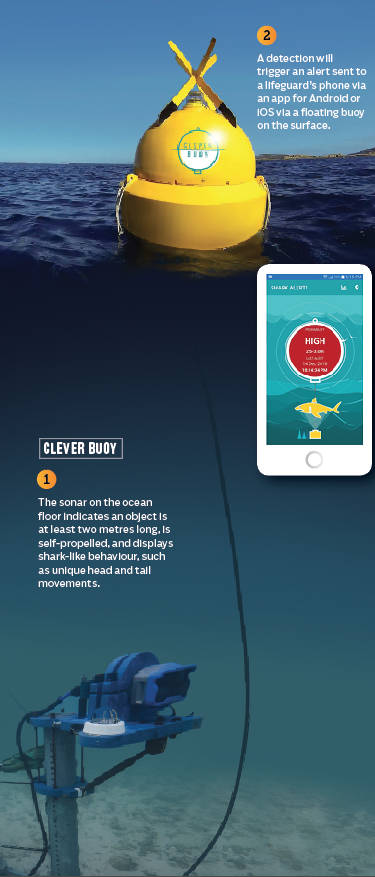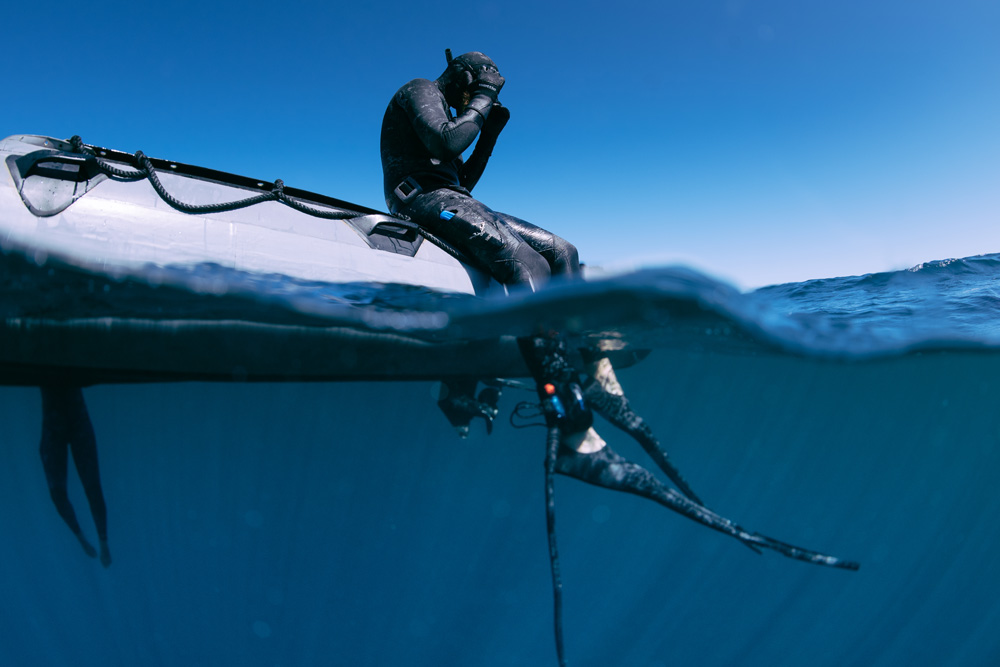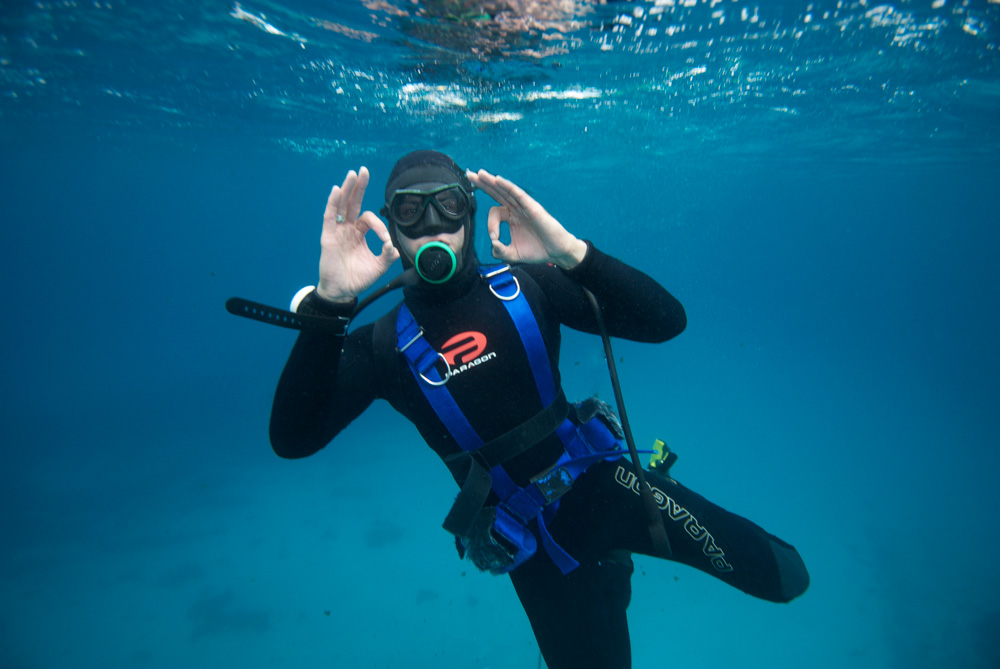Although rare, shark attacks do happen. Three projects currently under development are looking at using AI, sonar and even electric fields to keep close encounters to a minimum.
Thoughts of bull, tiger and great white sharks will haunt many beachgoers this summer. These three are the deadliest species of shark, according to a count by the Florida Museum of Natural History’s International Shark Attack File, which records all the way back to 1580.
For some perspective, its data includes 828 deaths since records began, and the organisation points out you’re 75 times more likely to be killed by lightning. However, sharks will show up at beaches from time to time, and sometimes even attack a person.
Last year there were 26 unprovoked encounters in Australia, with 16 injuries and two deaths. Efforts to make ocean-goers safer are highly varied, and range from controversial nets and drumlines to more novel ways including detection and warning, as well as various kinds of repellents.
Air support
Professor Michael Blumenstein heads Software at University of Technology Sydney’s Faculty of Engineering and IT. His PhD was in document analysis, enabling programs to read handwriting by deep learning methods. Following projects have brought him to the beach, and continue to do so.
“I have a background in pattern recognition and video image processing using computers and algorithms and artificial intelligence, and one of my earlier projects was looking at analysing beaches in relation to being safe,” he said.
“For example whether there were currents that we could detect, and rips, using video imagery. We did that as a project with the State Government in Queensland. I already had some expertise using video imagery detecting people, understanding ocean currents and things so this looked like a really good match. So detecting sharks, again for safety purposes, had a really great ring to it.”
He leads the SharkSpotter project, which began in early 2016 when the Ripper Group asked if shark-spotting by drone could be automated.
A hot field in the past few years, used for everything from language translation to mastering old Atari games, deep learning can be applied to a huge variety of tasks where there’s a lot of data to be learned and classification or prediction is required, said Blumenstein.
For SharkSpotter, video from the Ripper Group (and some that was publicly available) was used, with the system learning to discern between objects including swimmers, seals and sharks. The accuracy level for detecting sharks is about 90 per cent, though this is being increased.
Processing is carried out on an on-board GPU on the Vapor 55 RPAV drone helicopter, made by Pulse Aerospace, and which has a payload of 4.5 kg. According to the manufacturer, a battery charge will last for an hour’s flight time for the 1.95 m x 66 cm x 58 cm craft.
“There will be systems available to provide alarm mechanisms back to lifeguard towers and central stations,” adds Blumenstein, who sees the technology as something that will augment human staff on patrol, rather than replace them.
“There will be messaging and even potentially megaphone and other facilities on the drone itself to actually be able to warn the people in the water that there are hazards close by.”
Looking below
The air is, of course, not the only place from which sharks can be monitored.
One company, ASX-listed Shark Mitigation Systems (SMS), has developed a marine monitoring solution combining 720 kHz sonars and a pattern-matching algorithm they liken to facial recognition methods. SharkTec is based on Tritech International’s SeaTec software, originally used to detect sea mammals around tidal turbines in the North Sea.
 SMS’s Clever Buoy is a non-invasive, marine monitoring system, says Richard Talmage, General Manager at SMS and the lead for the product. He joined the company in 2015 and his background includes technology portfolio management for BHP and Rio Tinto.
SMS’s Clever Buoy is a non-invasive, marine monitoring system, says Richard Talmage, General Manager at SMS and the lead for the product. He joined the company in 2015 and his background includes technology portfolio management for BHP and Rio Tinto.
SharkTec picks out patterns from the sonar indicating an object is at least two metres long, is self-propelled, and that displays shark-like behaviour, such as unique head and tail movements.
“By removing any static reflections in the sonar image we can determine what the moving objects are,” Talmage said.
“The last step is in terms of looking at the probability of the swim pattern of that object exhibiting shark-like characteristics and matching that up against known signatures to determine the likelihood of that object being a shark.”
At the moment it can’t discern between shark species, but can detect sharks with around 90 per cent accuracy, according to Talmage (“we would rather have that one out of 10 false positives than miss any sharks”.) A detection will trigger an alert sent to a lifeguard’s phone via an app for Android or iOS. A first prototype of the Clever Buoy was completed in July 2014. It was refined and trialled in Sydney Aquarium, as well as the Abrolhos Islands and Esperance in Western Australia. A first live deployment at Bondi Beach, in 2016, followed.
“On the back of the Bondi deployment we had to do a short-term deployment for World Surf League in Jeffreys Bay in 2016. Then there was a full-beach safety trial in Western Australia for City Beach,” said Talmage of the December 2016 – April 2017 trial through WA’s Department of Premier and Cabinet.
At the time of writing, a report on this is being finalised. The solution has also found support from a US congressman and Orange County officials for a pilot of six sonar transducers with two buoys, which would operate at Corona del Mar in southern California.
As well as the Clever Buoy system, SMS has also developed two types of anti-shark wetsuits, designed to keep beach users safer by confusing a shark’s visual system. As nobody has developed one sure-fire way to completely rule out attacks, Talmage’s company may in the future consider combining their technology with a deterrent method – be it electrical, magnetic, chemical or other – to maximise effectiveness. Longer-term plans also include developing their system into something that does more than just detect sharks.
“There are lots of different deterrents on the market, though very few deterrents have been independently, scientifically verified to be effective. So at the moment, we’re focused on getting Clever Buoy from where it is today to a commercial grade of accuracy in detecting different marine species, primarily sharks, and then we’ll look at what is the right technology to pair it with,” he said.
“And if we’re talking about this in five years’ time I hope it’s more about a real-time marine monitoring platform capable of discerning between different species as well as real-time data on wave, wind, and environmental conditions, such as pollution.”
Ampullae evidence
Shark attack mitigation will always involve a mix of approaches, believes Lindsay Lyon, who acquired Shark Shield five years ago and is its managing director.
Lyon’s company has more claim to scientifically-proven validity, and its technology has been the subject of three peer reviewed papers.
Their line of products exploit ‘electroreception’, a kind of sixth sense sharks (and other elasmobranchs) have and use to home in on prey. Sharks possess thousands of organs known as ampullae of Lorenzeni: small pores that allow sharks to detect electrical fields created by other animals.

Sharks are able to detect as low as 0.005 microvolts, and Shark Shield overstimulates them, causing the elasmobranch discomfort and to quickly exit. Using two electrodes, the products create an elliptical electric field.
“The original electrical concept of deterring sharks was first developed in the Second World War,” said Lyon, an electronic engineer and entrepreneur.
“It was fine tuned by the South African Natal Shark Board, who are experts in White Sharks, in the 90s. Then Shark Shield further developed the technology through the 2000s.”
The march to mainstream acceptance has been gradual, though the company can now claim to have arrived. In May the WA Government offered a $200 rebate for the first 1000 divers and surfers purchasing a Shark Shield device. This year is expected to be the first profitable one in 15 years.
Show us the results
Associate Professor Charlie Huveneers has been fascinated by sharks since age 11. He has studied them all over the world, and still finds their behaviour hard to explain at times.
Most of his research around measures to keep people safer from them are around personal deterrents. He is frequently sought out to comment on the effectiveness of these.
However, even with the data, it’s hard to extrapolate findings.
“Sharks can react to many different things and it’s not because there’s one reaction to something that it’s specifically that deterrent. That’s why scientific testing is really necessary to be able to show if the repellent is efficient, to what extent it is, and what’s the resulting behavioural response,” he said.
He added, however, that there are many difficulties in properly knowing exactly to what a shark reacted. He has seen them approach bait and abort their path for no obvious reason. If there was a deterrent there, you might put it down to that. It can be unwise to draw too many inferences.
So is there a lot of rubbish out there? He politely declines to mention any specific product by name, but says there are a lot of unsubstantiated claims made.
“One of the dangers we’re seeing in some situations is where people would put themselves at greater risk than they would normally, because they believe in a product that might have not been tested scientifically,” he explained.
There is evidence that electromagnetic methods have some validity, but even then, caution is advised. Variables like salinity and temperature will change conductivity and therefore the propagation of the electric field, for example. As will the configuration of electrodes. The field produced is not uniform, so its effectiveness will vary depending on how a shark might approach it.
“Because of all of these differences, one product and the efficacy of one product cannot really be extrapolated or transferred to a different product in a different situation,” he said.
Real limitations
There are numerous products available claiming to deter sharks by electromagnetic, chemical, sound and other methods. Evidence for their efficacy is often slim.
A Choice review last year urged buyers to beware of some very real limitations, and several experts are on the record advising caution.
“Some devices have been tested, some devices are currently being tested, but a lot of devices currently have no proof whatsoever,” said Associate Professor Charlie Huveneers, who runs Flinders University’s Southern Shark Ecology Group research lab.
Lyon’s company is urging for Australian standards, and plans to rebrand in Q2 next year as Ocean Guardian, attempting to avoid being lumped in with a large range of shonky products with ‘shark’ in their name.

The company has also announced it has prototyped and is now testing and developing a new product, Ocean Guardian. The idea began when a French physicist contacted Lyon with a concept using a metamaterial transducer to greatly extend the possible range of the electric field in saltwater.
“We realised that we could measure about 20 microvolts at 30 m. A shark can sense down to
five nanovolts. We believe we can create an electromagnetic wave that’s propagating through the water for greater distances, to cause those gel-filled sacs to spasm from further away,” Lyon said.
At the time of writing, Shark Shield is seeking a way to take the concept further, through having experiments designed for validation.
“We have chatted with the New South Wales Department of Primary Industries about getting an existing shark net that catches the most sharks on average, and fit Ocean Guardian electromagnetic transducers to that net,” Lyon said.
“And then if you’re no longer catching any sharks in that net, it will be an indication that the technology is working.”
Though evidence has been published showing the success of its electric deterrents, the company does not claim to have a ‘silver bullet’ solution. No company or researcher in the field does.
The search continues.







